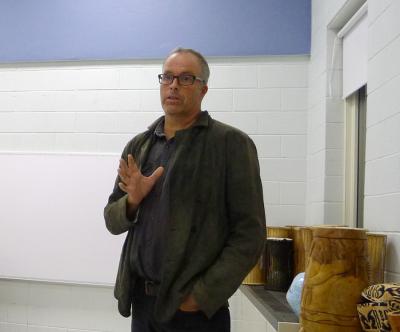Icy Reception for Surfrider's Montauk Beach Objections

Mike Bottini and Tom Muse of the Eastern Long Island Chapter of the Surfrider Foundation appeared before the Montauk Citizens Advisory Committee on Monday, hoping to persuade members to take a closer look at the Army Corps of Engineers’ proposed beach restoration project. The men, both of whom work in environmental fields, Mr. Bottini as a naturalist and nature writer and Mr. Muse as a landscape designer with his own firm, claim the plan will ruin the hamlet’s downtown public beaches.
They met with a frosty reception. They were accused of using scare tactics during their presentation, which included a slide show showing other primary dunes in Montauk that have been naturally sustained with sea grasses, some with strong rhizomes that anchor them to the dune and help prevent erosion. “Beach grass is nature’s great snow-fencing,” said Mr. Bottini.
The Army Corps project, which is expected to begin in the spring at an estimated cost of $9 million, calls for fortifying the beach with a 16-foot-high dune along 3,100 feet of shoreline, with a core of 14,000 “geotextile” bags filled with sand. The Town of East Hampton and Suffolk County have signed on and agreed to share the cost of annual maintenance, estimated at $157,000 each.
The two speakers said the project would consume most of the beach. They also said, and showed in pictures, other places in the nation where sand-filled bags used to stop erosion were uncovered and ripped apart in storms, leaving an unsightly mess. The type of sand used in the bags was another concern, and would most likely not be compatible with what is currently on the beach, they said. Mr. Muse said the bags would not only be exposed in a strong storm but would narrow the beach.
“You’re compromising the beach. You and your children are going to be walking and playing on geo-bags,” Mr. Bottini warned. He said motels should never have been built on a primary dune, and would not be subject to storm surges or full-moon tides had they been built farther back.
The speakers also said the town did not have the extra money it would need to maintain the artificial dune and asked where the funding would come from.
Aram Terchunian, a coastal consultant with the First Coastal Corporation, was at the meeting. Mr. Terchunian, who has worked previously with Montauk motel owners, claimed the men’s statistics and terminology were incorrect.
In a follow-up conversation yesterday, he said that the project would not take up the width of the beach as they had asserted. “They’re going to snuggle those bags up as close to the motels as possible,” he said, adding that the speakers had used incorrect terms to describe the bags, which are called geo-textiles. At one point, he said, they called them sand traps.
He said he had been happy to see the number of people in the room who agreed on the plan to fortify the beach. Montauk’s downtown beaches have been neglected for over 20 years, he said, and the motel owners have been the only ones helping to maintain them, to the tune of millions of dollars. “Now there’s a groundswell to solve the problem, and that’s what’s needed,” said the geologist.
Several committee members asked the men during their presentation what they would recommend. Mr. Bottini said that the natural dune should be replicated with sand and the motels should consider retreating from the site.
“The better way is to not build on these dunes, but we did, and now it’s our problem; it’s not just the motels’ problem. They’ve paid their taxes to the municipality and it’s now the municipality’s problem,” said James Grimes of Fort Pond Native Plants.
Andy Harris, a committee member, said the project was a temporary relief plan, and should be looked at accordingly. East Hampton Town Councilman Peter Van Scoyoc, the citizens’ committee’s town board liaison, agreed, calling the Army Corps project “a stopgap measure.”
Jeremy Samuelson, executive director of the Concerned Citizens of Montauk, recognized at the meeting and later said by email that his group's members are concerned about the type of sand that will fill the geotextile bags. They are worried as well, he said, about the town’s annual financial responsibility and think the $157,000 estimated is too low.
Mr. Samuelson said C.C.O.M. would like to know just how far seaward the proposed structure will extend and would like to see it moved closer to land. He said the project would not solve Montauk’s erosion problem. His group favors a soft solution, environmentally sound and economically feasible, backed by either a dune made of sand or geo-tubes covered in sand.
The project “may buy a few years to create a coastal resiliency plan that involves all stakeholders and creates incentives and financing mechanisms to reconfigure Montauk’s vulnerable infrastructure,” he said. “Downtown Montauk is going to look very different in 20 years, and we cannot leave it to fate to decide what those changes will be.”
Mr. Samuelson told the committee of an upcoming three-day conference called Climate Adaption for Coastal Communities that will be held at Stony Brook Southampton from Dec. 9 to 11. The conference, an intensive training program organized by the National Oceanic and Atmospheric Administration, will bring together national engineering and planning experts, providing them with a “climate adaptation tool kit” to address problems in the context of local government priorities. “We have to get the right people in that room,” Mr. Samuelson told the committee.
“If we’re at this point in the process where all these questions are being raised, then the Army Corps needs to provide more information," he said.
Correction: An earlier version of this article in print and online said that Concerned Citizens of Montauk advocates putting the Army Corps project on hold. According to C.C.O.M., that is not the organization's position.
